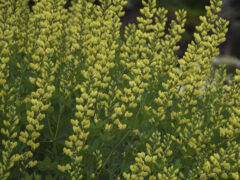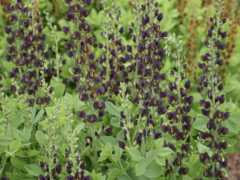Perennial Plant Association 2010 Perennial Plant of the Year!
Baptisia australis is an upright native perennial which occurs in rich woods, thickets and along stream banks from Pennsylvania south to North Carolina and Tennessee.
Easily grown in average, dry to medium, well-drained soil in full sun to part shade, false indigo grows best in full sun. Tolerates drought and poor soils. Plants form slowly expanding clumps with deep root systems that should not be disturbed once established. Shearing foliage after bloom helps maintain rounded plant appearance. Beautiful, showy native plant!
Plants feature lupine-like flowers in erect 12″ racemes over clover-like blue-green foliage. Spring flowers give way to inflated seed pods up to 2.5″ long which turn charcoal black when ripe and have considerable ornamental interest. Seed pods were once popularly used by children as rattles. Now we have iPods.
Stems with seed pods are valued additions to dried flower arrangements.
According to the North American Butterfly Association –
Blue Wild Indigo belongs to the plant family Fabaceae, also known as the pea family. Plants in this plant family feed a number of caterpillars. Depending on your location and availability of competing food plants (most notably crown vetch and alfalfa), the following caterpillars may use blue wild indigo for food:
Frosted Elfin: Caterpillars eat flowers and young seedpods. Frosted Elfin is not a common garden butterfly.
Orange Sulphur: Caterpillars eat the leaves of many plants in the pea family. Feeding occurs at night.
Clouded Sulphur: Caterpillars eat leaves of many plants in the pea family.
Hoary Edge Skipper: Individual eggs are laid in flower buds. Caterpillars eat flowers and seedpods. Hoary Edge is found only in localized populations and is not a common garden butterfly.
Wild Indigo Duskywing: A widespread butterfly that is fairly common in its range.
Eastern Tailed-Blue: A common garden butterfly. Caterpillar eggs are laid on flower buds and the caterpillars then eat the bud, flowers, and seeds.
Related Plants
‘Carolina Moonlight’ False Indigo
Baptisia sphaerocarpa x alba
'Carolina Moonlight' produces striking, tall yellow blooms in summer on hardy, low-maintenance plants. A great hybrid Baptisia. Baptisia is easy to grow and will thrive with little maintenance. There are many potential applications in the landscape including meadow plantings, as a backdrop in borders, or as a specimen. Plants are very long-lived once established.
TRY THE NATIVE!
[plant id="914"] [plant id="2153"]‘Dark Chocolate’ false indigo
Baptisia Decadence® 'Dark Chocolate'
Nearly black, charcoal purple flowers appear atop the compact clump of deep blue-green foliage in spring. Its smaller size makes it well-suited to urban landscapes.
TRY THE NATIVE!
[plant id="914"] [plant id="2153"]



